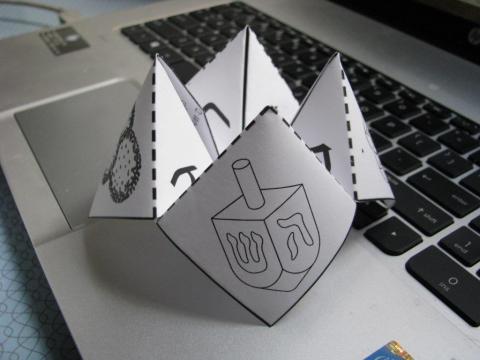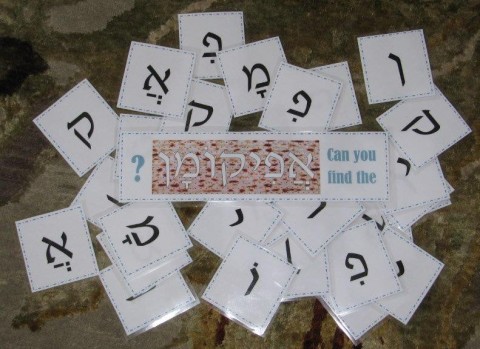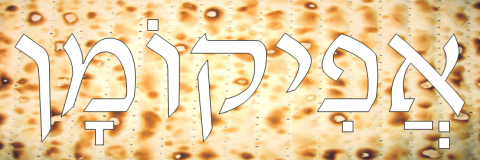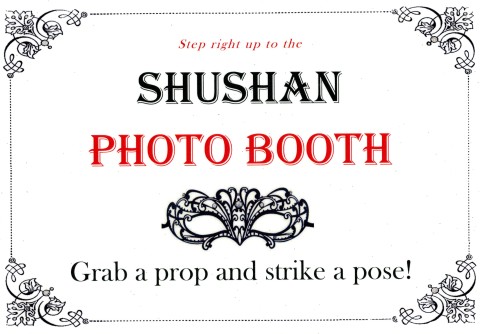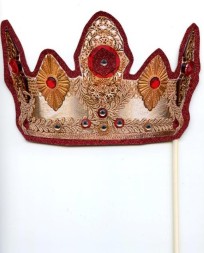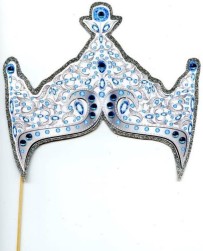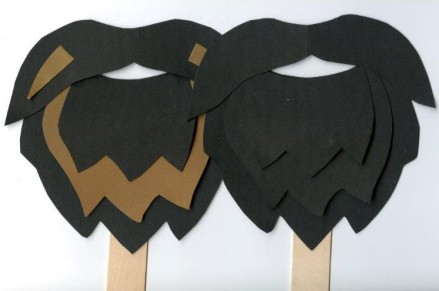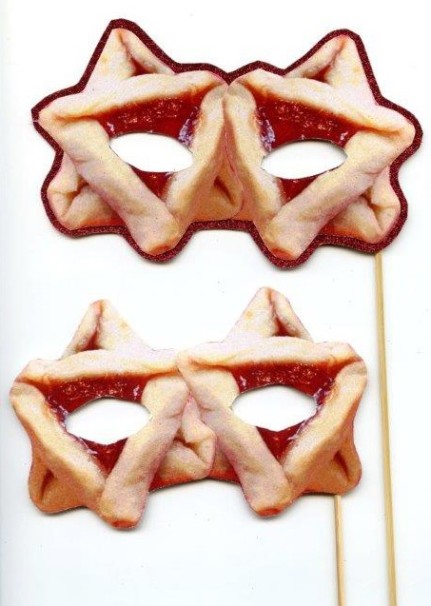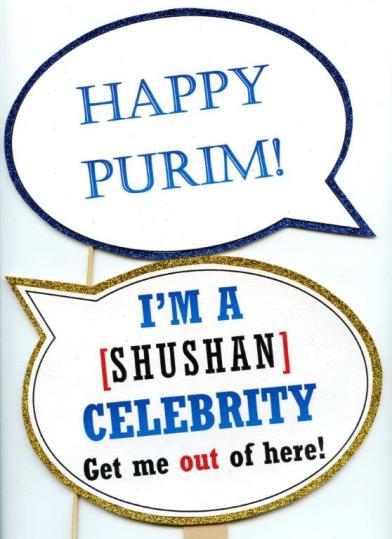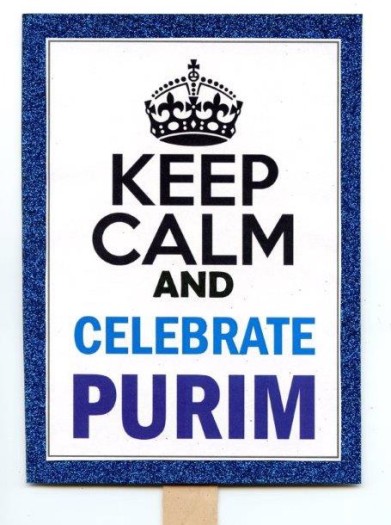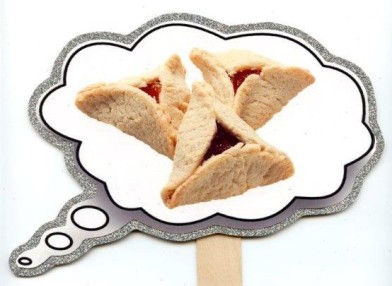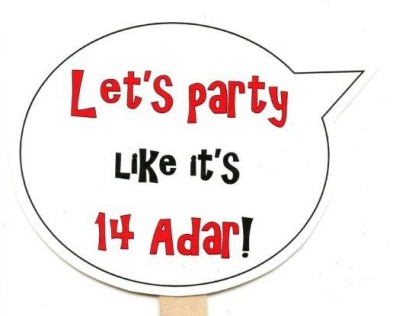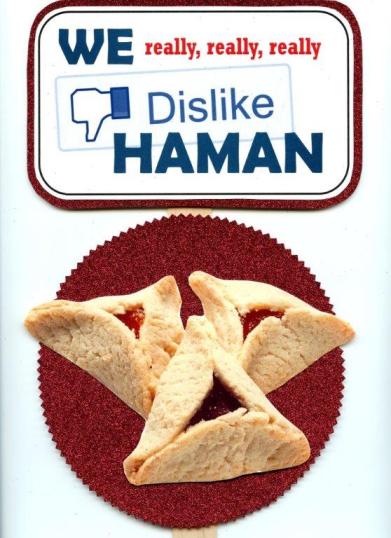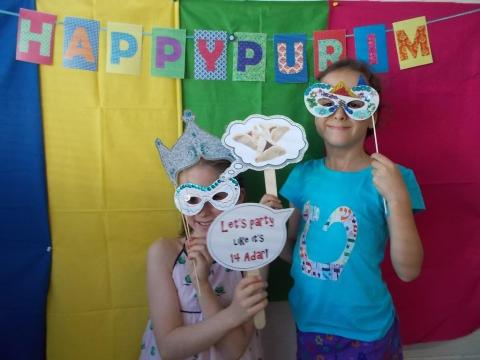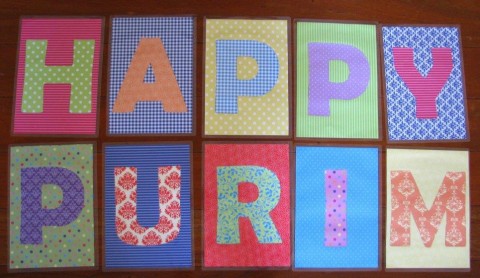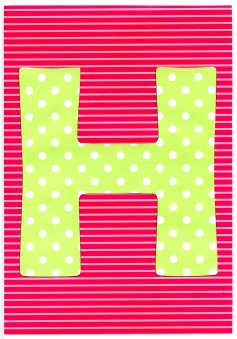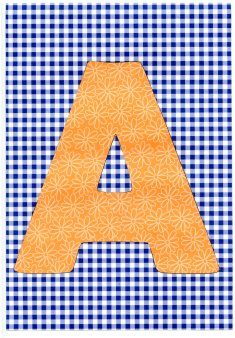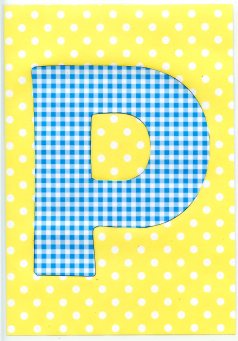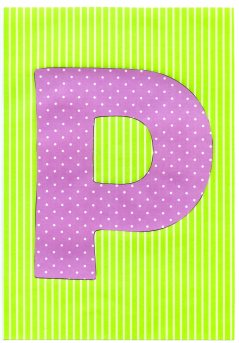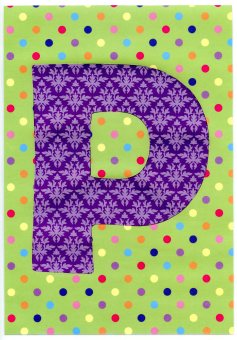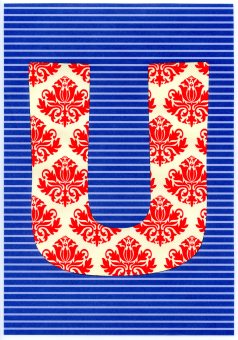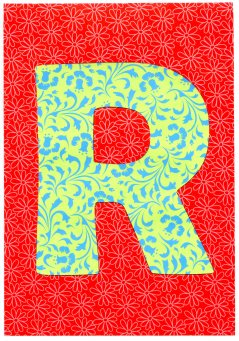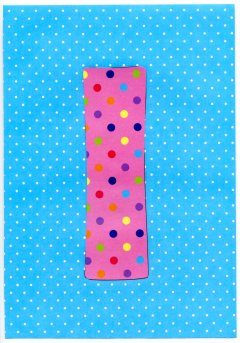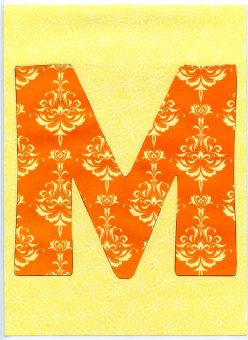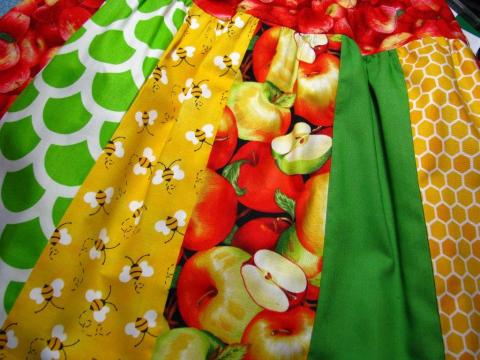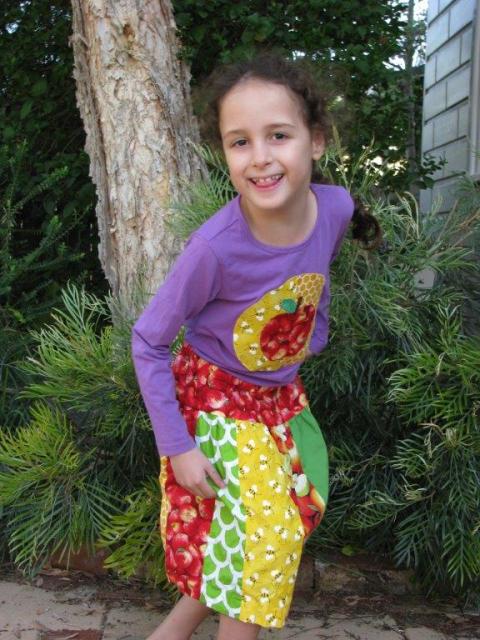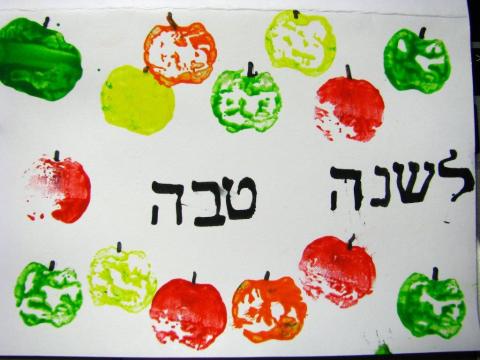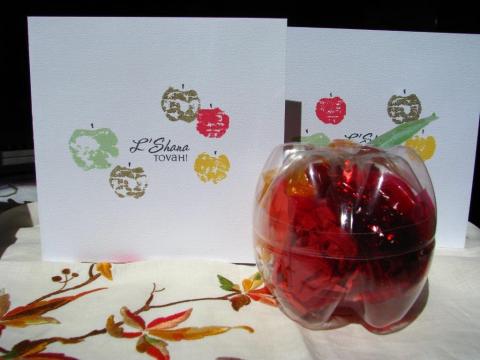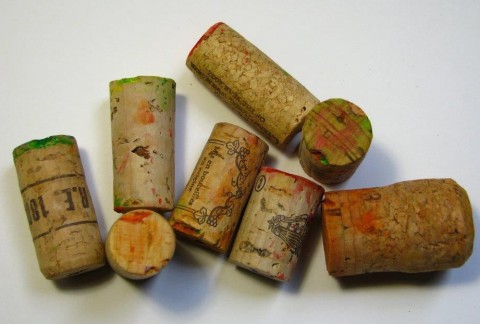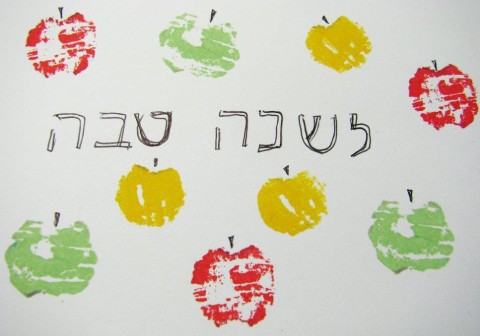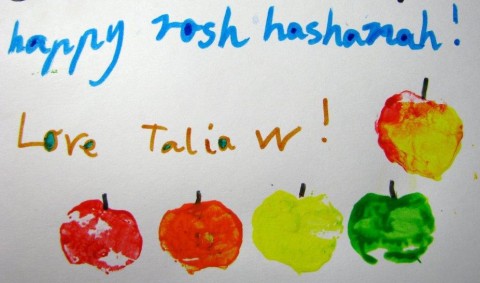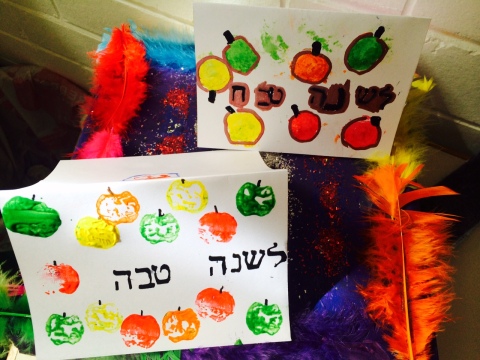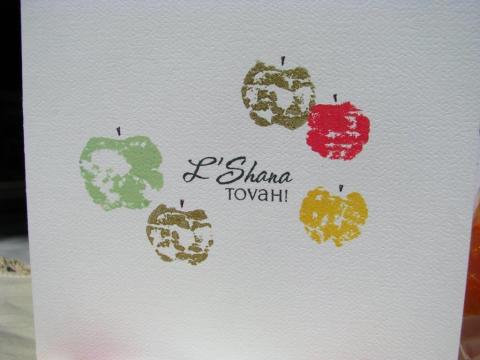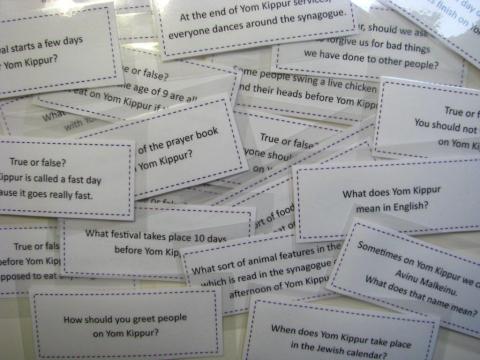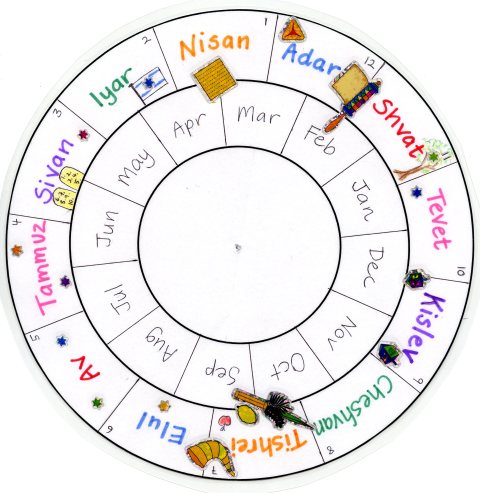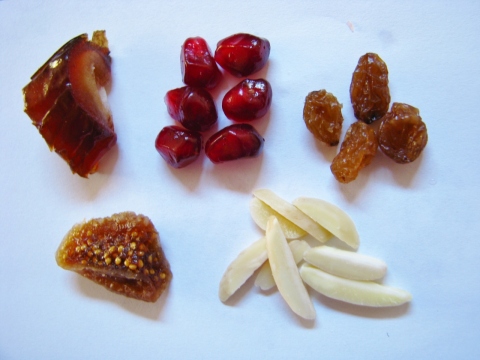Archive for the ‘Festivals’ Category
- In: Craft for kids | Festivals | Hebrew | Uncategorized
- 4 Comments
I remember making and playing with paper fortune tellers (also known as chatterboxes or cootie catchers) when I was a child. Earlier this year my daughter brought one home from primary school, proof that while much has changed since my childhood, much also remains the same. I was struck by the possibility of combining the eight internal faces of the chatterbox to the eight nights of Chanukah, an idea which I’m sure has many more possibilities than the simple one I have settled on for class this weekend.
I found a template online (google “chatterbox template” and you’ll see many) and filled it in. Depending on the age and ability of your children, and the amount of time you have available, they could fill it all in themselves, but this guarantees a minimum standard of completion and legibility!
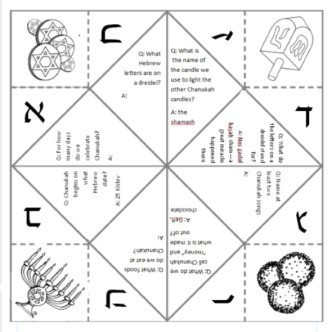 Black and white diagrams can be coloured in, children can practice the first eight letters of the alef-bet instead of counting to eight, and underneath each letter is a question relating to the festival. I left half unanswered so they can do a bit of work themselves before taking their new toy home and quizzing their parents.
Black and white diagrams can be coloured in, children can practice the first eight letters of the alef-bet instead of counting to eight, and underneath each letter is a question relating to the festival. I left half unanswered so they can do a bit of work themselves before taking their new toy home and quizzing their parents.
Instructions on how to fold a chatterbox can be found online – thank you again google.
You can download a printable pdf of my Chanukah chatterbox here. Or be brave, go make up one yourself!
Chag sameach!
This is a neat game for kids, combining the fun of a treasure hunt with some Hebrew learning!
The afikoman is the piece of matzah which is traditionally hidden during the course of the Passover seder for children to find later, and it becomes the last thing to be eaten at that seder.
In this game, I printed and laminated copies of each Hebrew letter in the word “afikoman” (which curiously enough is actually derived from a Greek word), and the full word. I made a set for each team taking part and hid the letters around the yard.
The rule was that only one child per team could run off to search at a time, and they could only bring back one letter. If it was a letter that team had already found, it needed to be rehidden. (Eventually the kids realised it was worthwhile checking and remembering which letters had been found before they ran off looking for another one!)
Quick, easy, and with a big enough yard, quite good exercise too.
You can download my copy of the Afikoman hunt cards here. Happy hunting!
Purim photo booth
Posted on: 1 March, 2015
Each year on the weekend before Purim, we run an activity session which always involves mask making or decorating. The younger children love anything involving cutting, sticking, sequins, feathers and glitter, but it can be difficult to enthuse the older ones, especially the boys. This year, only a few days before the session, I had the idea of incorporating a photo booth, with a range of Purim-themed props. It was fun to create, and the booth was a hit with kids of all ages.
The first thing I made was my advertising sign. As the Purim story is set in the city of Shushan, I decided the good folk of that town would be sure to enjoy a chance to dress up and smile for the camera. You can download a PDF of the Purim photo booth sign here.
I googled free photo booth props and found some fabulous Victorian-era handlebar moustaches and lips that could outpout Mick Jagger, but nothing which really took my fancy, so I decided to make my own.
In recognition of the key roles of Queen Esther and King Achashverosh in the Purim story – a pair of gem-studded crowns. For these, I selected, resized and printed out a couple of pictures of crowns found via google image; cut them out and attached them to glitter cardstock cut a little larger than each crown; and added a couple of stick on gems. Then I sticky-taped a kebab skewer to one side of the reverse.
Reflecting the historical likelihood of full manly facial hair – some cardboard beards. You can make your own – biblical beard prop instructions are here.
Celebrating a traditional Purim food in a non-traditional way – I may have invented hamanspectaschencles.
And then I just made up a bunch of different signs, thoughts and speech bubbles. It was fun. I had more ideas, but they will have to wait for another occasion.
You can print your own Purim photo booth signs here – just attach to cardboard and add a handle. I mostly used large plain popsticks from a craft store – they are the size of tongue depressors.
I pinned up some plain colourful fabric as a backdrop, ran an easy printable Purim banner across the top, and after the kids had made their own mask (or beard, or hamanspectashencles), I took their photos. It was loads of fun, and I’ll definitely be doing it again next year.
Printable Purim banner
Posted on: 28 February, 2015
After I constructed my paper Purim banner, I scanned the letters so I could print them out again without having to worry about any cutting and sticking. You can find the individual letters saved as .jpg files on the original post.
I saved all the letters at their original size into a PDF file – but the file was huge! I compressed the file, but this reduced the print quality. It is probably OK if you want something large (to be seen across the room) but are not too worried about how it looks up close. Purim banner – A4 size.compressed.
Next I saved them into a PDF file with each letter half as big: Purim banner – A5 size This file has a better resolution and should print fine.
I also ended up, somewhat by accident, with a PDF file which gives two copies of each letter, but with four letters per page. These are the perfect size for a couple of small banners for home or classroom – download it here: Purim banner – mini size
Print, cut out the rectangles, and sticky tape a piece of ribbon across the back. Try and leave slightly more space between the words than I managed on my first effort!
Happy Purim!
- In: Craft for mums | Festivals
- 1 Comment
Purim is fast approaching, and I wanted to put something colourful on the pinboard in the hall we use for Hebrew school. The easiest thing I could think of was a banner – or (time was running short) a bunch of letters arranged like a banner. Or indeed just a bunch of letters pinned to the board. [NB: the picture above is a not so great photo of the finished letters on the floor of my home. They look much better on the pinboard!)
Of course these letters needed to convey the joyful, party mood of Purim, so I decided to make them out of scrapbooking paper in a variety of colours and patterns.
These are simple to make if you have access to a printer. Make a template for the letters in Publisher or Word (or other text based software) by inserting a text box onto a blank page so that it fills almost the entire page. (It’s easier in Publisher, but if using Word, you will probably need to specify narrow margins in the Page Layout tab). Set the font to something which is going to be easy enough to cut out when very large. I used a font called Berlin Sans FB Demi, size 750pt. Into this box, type one letter. Use the formatting tools to set Font fill to “no fill” but keep Font outline as black (or any other colour).
Now you can print out this letter onto coloured paper. I like to buy packs of fancy scrapbooking paper when they are on special. I don’t actually scrapbook, I use the paper for papercuts, card making etc. The paper tends to be square (unlike your printer), but it’s not difficult to fold each piece and cut it to fit your printer tray, or trace around a piece of cardboard the size you need (A4 in my case). It doesn’t matter if the edges of these pieces are not perfect, because you will be cutting out the printed letter in the centre of the page.
Once you have the letters you need, attach each of them to a contrasting backing sheet. The letters I made would have looked fantastic on 12 inch square backing sheets, but I cut mine down to slightly smaller than A4 because I wanted to laminate them, and I only have A4 laminating pouches.
Well that looks great, I hear you say, but I don’t have time to faff around making a template and cutting up bits of coloured paper. No problem! After I made my letters, I scanned them. You can download individual letters from this page, or PDF files from here – (almost) no cutting or sticking involved.
The Rosh Hashanah skirt
Posted on: 16 September, 2014
- In: Craft for mums | Festivals
- 1 Comment
Last year I decorated a t-shirt for my daughter for Rosh Hashanah. She was very happy with it, but it didn’t match anything she already owned. So I promised her that this year I would make her a matching skirt.
Let’s just say that the last 12 months has gone really fast! Rosh Hashanah was looming on the horizon and I still hadn’t gone shopping for a skirt pattern. So I took advantage of the fact that (a) my daughter is young enough to appreciate anything I sew for her (b) I have a stash of groovy fabric (as seen in my Rosh Hashanah challah cover) and (c) the internet is full of useful sewing blogs explaining how even people like me – with very limited sewing skills – can still easily rustle up a fun skirt.
It’s loud, it’s proud, and my daughter loves it. Maybe next year I should make my husband a matching kippah?
Looking for a fun and easy Rosh Hashanah card craft? This is a variation on an activity I saw on the Challah Crumbs website. Basically it involves printing apples using the usefully circular nature of the end of a cork. This may be easier said than done if you don’t drink wine – or even if you do, given how much less common wine bottles with corks are these days. It might be time to pop that bottle of champagne you’ve been saving for the right occasion. 🙂
Fortunately for me, I saved a bunch of corks some years ago with the plan of making an entire pinboard out of recycled corks. The pinboard never eventuated, but the corks were still hanging around. (Yes, I am that sort of person who finds it hard to throw things away, how did you guess?)
Rather than keeping the corks completely round, I used a cutting blade to take out two small chunks to mimic the dimples at the top and base of an apple. The stems are just added in pen afterwards.
Corks are not uniformly flat, especially once you’ve impaled them with a corkscrew, but this adds to their charm in my opinion. I initially tested my cork stamps with ink pads, and I really liked the result. The handwritten Hebrew letters are less of a feature, but I was making this in a rush as a demonstration model for a class of children who were not going to be critical (thankfully!) I gave them some Hebrew alef-bet stencils and they enjoyed finding the right letters for their own cards.
We don’t have colourful inkpads at cheder, so there we used paint. It worked fine, but if you are doing this activity with kids then I recommend you have a scrap sheet of paper or cardboard where kids can stamp first to lose some excess paint prior to stamping their Rosh Hashanah card. This is because if you have too much paint on the end of your cork, you end up with a blob which looks less like an apple and more like somebody stepped on a paint bug and squished it to the page.
The advantage of paint is that you can end up with mixed colours which look fabulous, as my daughter demonstrates above.
Rosh Hashanah is in less than two weeks, so I foresee more cork stamping at home this weekend!
Update: I made cards for family on the other side of the country using ink, with a stamped greeting in the middle. I was pretty happy with how they turned out. It’s not so obvious from this photo, but the metallic gold apples looked great.
Yom Kippur quiz for kids
Posted on: 8 September, 2014
- In: Festivals
- 2 Comments
I was teaching a group of children aged 6-9 about Yom Kippur facts and customs recently, and I decided to do it in the form of a group quiz. I printed out my questions and laminated them, then my class took turns pulling a question out of a bag and reading it aloud. That was good because even the ones who were reluctant to venture an answer still contributed to the activity. Nearly half the questions are “True or False?” which the kids seemed to enjoy. My 7 year-old daughters says this is because you have a 50% chance of getting it right! I was not fussed if they already knew the answer or not, I wanted them to think about it and then I helped fill in the gaps in their knowledge.
You are welcome to use these questions yourself. This link should open up a .pdf file: Yom Kippur Quiz
Some questions ask for basic knowledge: “What is the traditional colour to wear on Yom Kippur?” Some test understanding of vocabulary: “True or false? Yom Kippur is called a fast day because it goes really fast.” Other questions are more subtle: “True or false? Yom Kippur is a day for asking other people to forgive us.”
And there are a bunch of other questions as well, involving goats, shoes, chickens, eating, and the festivals on either side of Yom Kippur, among other things. As much fun as you are likely to have learning about this very serious festival!
Be warned: I am not providing the answers! You may need to do a little revision. 🙂 It also allows for some variations on answers to suit your own practices. Plus you may find the kids come up with more than you expect. In response to a question about goats, I had only planned to talk about scapegoats, but a boy in my class immediately pointed out the obvious connection between goats and the shofar.
May we all be inscribed for a year of learning!
Jewish months calendar
Posted on: 29 June, 2014
I wanted a simple calendar for my classroom which would show the entire Jewish year at a glance. So I made this:
It is a laminated circle showing the Hebrew months set against the Gregorian calendar months. I used a split pin (brad) to attach it to a backing piece of cardboard, so that you can rotate it as the year goes past. (It actually was Adar when I made it!) I put a second circle in the middle which does not need to rotate, and my original plan was that this would cover the brad. Unfortunately I couldn’t find a brad which was large and flat enough that the circle would stick to it – so I had to put the brad through both circles.
Admittedly it is only approximate, and does not take into account leap years (when the Jewish calendar gains an entire extra month), but it does show the whole cycle of the year at once which was my main requirement. I added stickers or drew pictures to indicate the main festivals. I think this would be a great project for kids who are learning the names of the months of the Jewish calendar.
I made it by drawing concentric circles on the computer and then using a quilting ruler as a protractor to add the “spokes” after I had printed it. You are welcome to use my template for the circles and add your own spokes and text.
I decided when I made it to write the months going anti-clockwise around the circle, but I notice now that every other circular, perpetual Hebrew calendar I can see on Google goes clockwise, so my classroom calendar might be unique in more ways than one! However as long as the months are in the right order, I guess it doesn’t really matter too much.
Seven species biscuits
Posted on: 26 June, 2014
- In: Craft for kids | Festivals | Recipes
- 1 Comment
Last Tu Bishvat, I organised a snack activity to tie in with the theme of the Seven Species, “shivat haMinim”. These are the grains and fruits listed in the Torah as being special products of Eretz Yisrael, the land of Israel: “a land of wheat and barley, and vines and fig-trees and pomegranates; a land of olive-trees and (date) honey”.

It’s not so easy to combine all these species into one child-friendly snack, so I cheated slightly by replacing olives with almonds (as almond trees blossom in Israel around the time of Tu Bishvat) and gluing the lot together with chocolate icing. It was delicious!! (We also offered the kids bread with olive oil for dipping, so no species was missed out.)
All you need is a packet of Malt biscuits (which contain both wheat and barley)

and some chopped up fruit (specifically: dates, dried figs, pomegranate seeds and sultanas) and slivered almonds
and a quantity of home-made chocolate icing (or something similar) to hold the fruit and nuts in place.
Spread the biscuit with chocolate icing, load up with date, fig, pomegranate, sultanas and almonds – some of the kids even made little pictures out of their toppings – and eat! This was so quick and easy to organise, and so popular, I can guarantee we’ll be doing it again.

